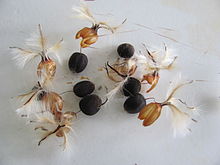Leucadendron argenteum: Difference between revisions
Extended confirmed users 12,489 edits quotation marks, ref markup |
AWB |
||
| Line 4: | Line 4: | ||
|image = Leucadendron argenteum - Silvertree Forest - Cape Town 1.JPG |
|image = Leucadendron argenteum - Silvertree Forest - Cape Town 1.JPG |
||
|image_caption = A young Silvertree at [[Kirstenbosch Botanical Gardens]], [[Cape Town]] |
|image_caption = A young Silvertree at [[Kirstenbosch Botanical Gardens]], [[Cape Town]] |
||
|status = |
|status = VU |
||
|status_system = |
|status_system = IUCN2.3 |
||
|status_ref = <ref name=iucn>{{Cite journal | author = Hilton-Taylor, C. <i>et al.</i> | title = ''Leucadendron argenteum'' | journal = [[The IUCN Red List of Threatened Species]] | volume = 1998 | page = e.T30350A9539214 | publisher = [[IUCN]] | date = 1998 | url = http://www.iucnredlist.org/details/30350/0 | doi = 10.2305/IUCN.UK.1998.RLTS.T30350A9539214.en | access-date = 9 December 2017}}</ref> |
|||
|regnum = [[Plantae]] |
|regnum = [[Plantae]] |
||
|unranked_divisio = [[Angiosperms]] |
|unranked_divisio = [[Angiosperms]] |
||
| Line 81: | Line 82: | ||
==References== |
==References== |
||
* {{IUCN2006|assessor=Hilton-Taylor, C. |display-assessors=etal |year=1998|id=30350|title=Leucadendron argenteum|downloaded=11 May 2006}} Listed as Vulnerable (VU D2 v2.3) |
|||
{{Reflist}} |
{{Reflist}} |
||
| Line 90: | Line 90: | ||
{{ |
{{Taxonbar}} |
||
[[Category:Leucadendron|argenteum]] |
[[Category:Leucadendron|argenteum]] |
||
[[Category:Endemic flora of South Africa]] |
[[Category:Endemic flora of South Africa]] |
||
Revision as of 13:41, 9 December 2017
| Silver tree | |
|---|---|

| |
| A young Silvertree at Kirstenbosch Botanical Gardens, Cape Town
| |
| Scientific classification | |
| Kingdom: | Plantae |
| (unranked): | Angiosperms |
| (unranked): | |
| Order: | |
| Family: | |
| Genus: | |
| Species: | L. argenteum
|
| Binomial name | |
| Leucadendron argenteum | |

| |
| Map of the extant population of Silvertrees in the Cape Peninsula | |
| Synonyms[2] | |
| |
Leucadendron argenteum (Silver tree, Silver leaf tree,
Appearance

The Silvertree is a striking
Distribution
This enormous silver
In addition there are two tiny outlying populations nearby, in Stellenbosch and Paarl (It has not yet been established for certain whether these are natural outliers, or were planted here in early Cape history).
Historically, the Silvertree was more widespread on Table Mountain, covering much of its slopes in shimmering silver forests. However, early demand for timber led to much of these forests being felled and now the Silvertree is a rare and endangered species.[4]
Status and conservation

Table Mountain is perhaps the only place where these trees grow naturally, as the populations near Stellenbosch and Paarl (though conceivably natural) may have been introduced from Table Mountain.
In the face of urban development, inappropriate fire management, and invasive alien trees such as pines and gums, silvertrees have been driven from about 74% of their natural range.[5] Mortality of these short-lived trees is negligible after a burn, but then increases to about 5% per annum. During a longer term absence of burns however, sudden die-offs may occur, even in a matter of hours. This is believed to be the combined result of (warm) berg winds and diseased roots which are weakened by Phytophthora root rot which inhibits their water absorption.
An estimated 40 to 50 percent of the extant native population burned in the fire of 26 to 27 January 2006.[6] As recruitment of seedlings only occurs naturally after fire, this was a necessary stage in the life-cycle of this Fynbos species, and the population has recovered totally.
A major deterrent to propagation of the silver leaf tree is its short life span, as most don't live more than 20 years. This doesn't affect their conservation however, as fires rejuvenate populations on average every 15–20 years by killing the surviving adults and triggering the release of the canopy seed bank (in the cones), and germination of the soil seed bank. Seeds remain viable for at least 80 years. Juveniles take 5–7 years to flower and set seed, whereafter the populations are ready to burn again.
Heraldry
"[S]tylized twigs of the silver tree" [sic] appear in the arms of the South Peninsula Municipality of South Africa.[7]
Pictures
-
Silvertrees were driven to near extinction when their natural habitat was cleared for commercial pine plantations.
-
Silvertrees grow only in and around Cape Town, particularly on Table Mountain.
-
A large Silvertree near Rhodes Memorial
-
A young stand of Silvertrees on Devil's Peak, Table Mountain.
-
A Silvertree forest on the lower slopes of Devil's Peak
-
Partial removal of the invasive pine plantations allowed Silvertree forests to gradually return.
-
Silver tree leaves are soft and silky.
-
New growth detail
-
The silver leaf colour is due to their soft velvety hair
-
Heavy cone of a female tree, which eventually opens to release the small, round nuts
-
Cone, seeds, leaf and juvenile plant
See also
- List of Southern African indigenous trees
- Peninsula Granite Fynbos
- Silwerboomkloof
- Rhodes Memorial
- Newlands Forest
References
- . Retrieved 9 December 2017.
- ^ The Plant List: A Working List of All Plant Species, retrieved 27 December 2016
- ^ "Protected Trees" (PDF). Department of Water Affairs and Forestry, Republic of South Africa. Archived from the original (PDF) on 5 July 2010. Retrieved 13 June 2013.
{{cite web}}: Unknown parameter|deadurl=ignored (|url-status=suggested) (help) - ^ "IDM Cape Peninsula - Ld arge". www.proteaatlas.org.za. Retrieved 2017-08-02.
- ^ "Threatened Species Programme | SANBI Red List of South African Plants". redlist.sanbi.org. Retrieved 2017-08-02.
- ^ http://www.news24.com/News24/South_Africa/News/0,,2-7-1442_1871014,00.html
- ^ http://www.national.archsrch.gov.za/sm300cv/smws/sm30ddf0?20060828203950B6626546&DN=00000010
External links
- Leucadendron argenteum Plantzafrica.com
- Leucadendron argenteum at the University of Pretoria website
- Leucadendron argenteum in the Protea Atlas













